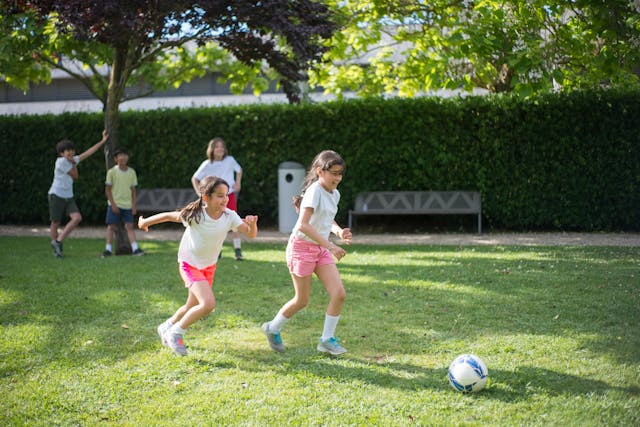7 Signs of Teacher Burnout: Navigating Exhaustion in Preschool Educators
As a preschool teacher, the journey of shaping young minds is undeniably rewarding. However, the reality is that this noble profession often comes with its own set of challenges. Today, let’s embark on a narrative journey to uncover the subtle yet profound signs of teacher burnout and explore the ways it impacts both educators and the children they guide through those crucial early years.
Did you know that teacher burnout can have a significant impact on your child’s growth, mental health, and learning?
Picture this – you drop off your energetic toddler at preschool, but lately, you’ve noticed something different about their beloved teacher. Could it be burnout? In this blog post, we’ll explore the signs of teacher burnout and how it could affect your child’s early education experience.
This Blog Contains:
- Summary
- What is Teacher Burnout?
- Symptoms of Teacher Burnout
- 7 Signs of Teacher Burnout
- How to Prevent Teacher Burnout: 7 Tips
- What Parents and Schools Can Do to Help Teacher Burnout
- Conclusion
Summary:
In this blog, we will dive into the depths of understanding teacher burnout, exploring the signs that often go unnoticed, and shedding light on how it transcends beyond personal struggles, affecting the very fabric of a child’s learning environment. From the early warning signals to proactive measures, we’ll navigate the landscape of teacher burnout, armed with insights to foster a healthier educational setting.
What is Teacher Burnout?
Teacher burnout is not merely a fleeting stress episode; it’s a prolonged state of chronic work stress that can have lasting effects on a teacher’s physical, emotional, and mental well-being. This silent struggle manifests as a decline in passion, motivation, and overall job satisfaction. The toll it takes extends beyond the individual, affecting the quality of education and the teacher’s ability to create an engaging learning atmosphere.
The Four Telltale Symptoms of Teacher Burnout
Teacher burnout is more than a silent problem—it’s a deafening cry that echoes through classrooms nationwide. Recognizing burnout symptoms and impacts can lead us to the lighthouse in the middle of this storm. Let’s dive deep into the four major warning signals of teacher burnout and unveil their far-reaching implications.
1. Exhaustion: The Invisible Thief
Teaching can be an intense and demanding job, often draining a teacher’s energy reserves. Teacher burnout stealthily creeps in, accompanying teachers as they become worn out physically, mentally, and emotionally. This exhaustion transforms the once-dynamic tasks of lesson planning, classroom management, and meeting academic goals into daunting challenges. Persistent fatigue, even after rest, is a hallmark sign of teacher burnout.
2. Depression: The Emotional Abyss of Burnout
The ripples of teacher burnout often reach the serene shores of a teacher’s emotional health. An aura of sadness, feelings of hopelessness, and an indifferent attitude might be signs of the lurking shadow of depression.
As the fun seeps out of their once-enjoyed activities and negativity hovers like a stubborn cloud, teachers struggle to find fulfilment in their work.
Depression is not just a personal hurdle—it can ripple into their interaction with students and dent their job satisfaction.
3. Physical Ailments: The Silent Scream
Teacher burnout doesn’t limit its reach to the mind and emotions—it can also manifest as physical symptoms.
Chronic stress and fatigue can trigger a range of health issues, from persistent headaches and frequent illnesses to muscle tension and sleep disturbances.
Pay attention to these body signals—they’re a distress call for support.
4. Withdrawal: The Unsung Solitude
Teacher burnout can isolate educators, prompting withdrawal from colleagues, students, and even personal relationships. Teachers might withdraw socially, slowly slipping away from their colleagues, students, and loved ones. Once active participants in school functions or eager collaborators with peers may start feeling detached and disconnected. This voluntary isolation can disrupt teamwork, and collaboration, and, in the long run, strike at the heart of the school community.
Top 7 Signs of Teacher Burnout
Just like any superhero movie, teacher burnout has its fair share of warning signs. Let’s dive into the seven crucial indicators you should be aware of.
1. The Stage of Exhaustion: Crumbling Superpowers
Chronic exhaustion stands out as a significant signal and cause of teacher burnout. Teachers on the brink of burnout may seem to be in a constant state of fatigue, affecting them both physically and mentally. Previously energetic and dynamic in their teaching approach, these teachers may start to lose their spark, resulting in a noticeable drop in student engagement.
If a teacher consistently appears energy-deprived, struggles to stay awake, or seems perpetually worn out, it could indicate looming teacher burnout.
2. Emotional Weariness: The Transformation of Laughs to Sighs
Teachers have a knack for cultivating a welcoming and lively learning atmosphere. However, burnout can considerably impact their emotional resilience, driving them towards emotional fatigue. You could notice that the teacher who used to flash countless smiles daily has now grown irritable, quick to frustration, or even displays indifference towards their students.
Symptoms like mood fluctuations, irritability, or even letting tears stream freely, can indicate emotional exhaustion. When sunny smiles morph into downcast frowns, it’s high time to lend a supporting hand.

3. Persistent Indifference: The Dimming Spark
Have you been witnessing a slow, yet steady, decline in your child’s teacher’s enthusiasm or passion? This sluggish disinterest, or apathy, is a critical symptom of teacher burnout that shouldn’t be dismissed. The zest for teaching could dwindle due to burnout, triggering a drop in motivation and interest, evident in their decreasing excitement for lesson planning, student engagement, or participating in school events. Start ringing alarm bells if you spot this fading sparkle. Interventions and support can reignite their teaching passion.
4. Subpar Performance: Forgotten Assignments and Deadlines
Teacher burnout can take a heavy toll on their professional performance. Burnout-stricken teachers may start floundering when confronted with deadlines and fulfilling their responsibilities. They may grapple to draft lesson plans, grade schoolwork, or carry out administrative tasks.
Signs like missed deadlines, overlooked classes, or compromised quality of teaching resources suggest burnout-induced performance decline. Recognizing these signs lays the groundwork for interventions, helping them reclaim their organizational dexterity and efficacy in the classroom.
5. Frequent Absences: The Now-You-See-Me Game
More frequent absences are a pretty apparent indication when teacher burnout escalates. Overwhelmed by exhaustion, burnt-out teachers might need more recuperating time, often requesting sick leaves or time off. This increased absenteeism can disrupt your child’s educational continuity and also flags the compromised teacher’s well-being. Closely monitoring their attendance pattern can aid in recognizing and countering this problem.
6. Abandoning the Classroom: Teacher-Student Relationship Turns Cold
Among the disconcerting signs of teacher burnout is when teachers start pulling away emotionally from their students. Teachers, usually cherished for their warm rapport with students, could turn emotionally detached and withdrawn due to burnout. This affects their empathy towards students, dampening the nurturing supportive classroom environment they once fostered. Observing changes in the teacher-student interaction is important; so is voicing your concerns at the earliest.
7. Unhealthy Coping: From Caffeine Overdose to Tipple Troubles

Battling burnout, some teachers might adopt detrimental coping mechanisms for temporary relief.
Teachers relying heavily on caffeine, leading to excessive coffee drinking, is not unheard of. Stress, when it crosses the manageable threshold, might drive them towards more harmful pathways, like excessive alcohol consumption, pointing towards a larger issue. Realizing this change is pivotal, as it unravels their struggle with stress management and the necessity for healthier restorative routes.
Read our blog post to identify the signs of a subpar preschool teacher and gain valuable insights.
How to Prevent Teacher Burnout: 7 Tips
1. Prioritize Self-Care:
Prioritizing self-care involves recognizing the importance of personal well-being and taking intentional steps to maintain a healthy work-life balance.
Example: Sarah, a dedicated preschool teacher, understands that to give her best to the children in her care, she needs to recharge. Despite her busy schedule, she allocates time each week for activities she enjoys, whether it’s reading a book, taking a walk in the park, or engaging in creative hobbies. By prioritizing self-care, she replenishes her energy and approaches each day with renewed enthusiasm.
2. Set and Keep Clear Work Boundaries:
This tip involves establishing clear boundaries for work-related communication and tasks to prevent work from encroaching on personal time.
Example: Mark, a seasoned preschool teacher, communicates to parents that he will respond to emails during work hours and within a 24- to 48-hour timeframe, except for urgent matters. By setting these boundaries, he ensures that he has dedicated time for personal life, reducing stress and preventing burnout.
3. Identify Early Warning Signs:
Recognizing early warning signs involves cultivating self-awareness to detect signs of stress or exhaustion before they escalate into burnout.
Example: Emma, a proactive preschool teacher, keeps a journal to track her mood, energy levels, and overall well-being. Recognizing early signs such as persistent fatigue or irritability, she can take timely action, implementing coping strategies before burnout takes hold.
4. Seek Connections:
Seeking connections involves actively building relationships with colleagues and creating a supportive work environment.
Example: James, a passionate preschool teacher, participates in regular team-building activities, fostering strong relationships with fellow teachers. This network of understanding and empathy acts as a buffer against stress and burnout.
5. Be Kind to Yourself:
Being kind to oneself involves practicing self-compassion and acknowledging that teaching is a demanding job.
Example: Maria, an empathetic preschool teacher, practices self-compassion when facing challenges. She reminds herself that it’s okay to acknowledge the difficulty of teaching, adopting a kind and understanding attitude towards herself to boost her overall sense of well-being
6. Talk it Out:
Talking it out involves opening up to trusted colleagues or friends about the symptoms and challenges of burnout.
Example: Alex, a dedicated preschool teacher, talks to a trusted colleague about the symptoms of burnout he’s experiencing. By sharing his feelings and concerns, he gains valuable insights and support, breaking the isolation often associated with burnout.
7. Evaluate Your Options:
Evaluating your options involves actively assessing your workload and discussing concerns with school administration to explore practical solutions.
Example: Olivia, an experienced preschool teacher, assesses her workload and discusses her concerns with the school administration. Together, they explore strategies such as delegating tasks, providing additional support, or adjusting responsibilities. By actively seeking solutions within the school community, she ensures a collaborative approach to managing workload and preventing burnout.
What Parents and Schools Can Do to Help Teacher Burnout
Remember, every superhero needs a support system to conquer adversity. Let’s explore how parents and schools can join forces to battle teacher burnout.
Initiate Transparent Talks: Unleashing the Power of Conversation
Fostering intercommunication between parents and educators is a highly effective way to address and possibly thwart teacher burnout. Encourage discussions brimming with truth and compassion by routinely initiating conversations with your child’s mentor. Vocalize your apprehensions, extend a helping hand, and lend an analytical ear to their hurdles.
The creation of a safe ambience for cordial talks can enlighten parents about the teachers’ needs and cooperation on fruitful solutions. Healthy communication can pave the way towards a stress-free, supportive environment eventually also enhancing the wellness quotient of teachers and their pupils.
Advocate for Work-Life Harmony: Weighing the Justice Scales
The harmony of work and personal life is a linchpin to fend off and battle teacher exhaustion. Parents and educational institutions share a significant role in cultivating this harmony through an understanding of teaching responsibilities and by endorsing self-care habits.
Schools can execute policies that rank realistic work volumes, enable flexibility, and equip teachers with adequate resources. Parents can foster work-life balance by honouring professional boundaries – understanding the essence of personal time, and championing policies laying emphasis on the teachers’ well-being. Work-life balance can significantly contribute to the overall happiness and health of educators, thus enhancing their capability to impact students positively.
Ensure Professional Growth: Kindling the Superpowers
Perpetual professional development acts as the lifeblood of teacher growth and satisfaction in their job role. Parents and schools can synergize to offer substantial professional development opportunities that empower teachers to refine their skills, keep themselves abreast with cutting-edge educational practices, and discover their passions. By investing in professional development, schools can demonstrate their devotion to the flourishing and success of their teachers.
Parents can support this by endorsing essential training programs and resources, such as BetterHelp, that are in alignment with the education requisites of their child. Empowering teachers through professional growth not only aids teachers in combating burnout, but it also positively contributes to the overall enrichment of the academic experience for each student.
Nurture a Positive School Atmosphere: Erecting a Fortress of Support
Carving a positive school culture requires a joint effort from parents, school administrators, and the larger school population. An environment that resonates with support and care can create a significant effect on the mental well-being and job satisfaction of teachers. Schools can stimulate a positive culture by appreciating accomplishments, endorsing collaborative activities, and laying emphasis on teacher mental health.
Simultaneously, parent contribution is equally effective- establishing rapport with the school community, endorsing school efforts, and expressing gratitude for the relentless commitment of teachers and staff. By building a strong supportive system, parents and schools can substantially protect teachers from exhaustion, enabling them to excel and augment the quality of education for their students.
Exhibit Gratitude: Harness the Superpower of Appreciation
Recognition and appreciation can go a long way in elevating teacher spirit and avoiding burnout. Parents and schools can manifest gratitude for the hard work, commitment, and positive influence teachers render in their children’s lives. Simple, heartfelt gestures like dispatching thank you notes, verbalizing gratitude, or organizing appreciation-centric events can impact significantly.
School establishments can also promote recognition programs applauding teachers’ accomplishments and input. By acknowledging and appreciating the tireless efforts of teachers, parents and schools can create a supportive atmosphere, reaffirming the value of their work and encouraging them to forge ahead with their noble mission.
Read more on the Benefits of being a Preschool Teacher
Read more on Step by Step Guide on How to Become a Preschool Teacher in Singapore
Wrapping Up!
As a preschool teacher and caretaker, understanding the causes of teacher burnout is vital for our children’s educational success. We can become the unseen heroes, lending support, empathy, and aid to teachers as they confront their profession’s challenges.
By spotting teacher burnout early and acting decisively, we contribute to a healthy education ecosystem where our children’s talents can thrive.
Active vigilance helps craft a positive learning environment. Addressing teacher burnout head-on equips educators with the strength to excel, fostering a climate for growth. Together, we can tap into our children’s potential, fueling their academic, social, and emotional development.









